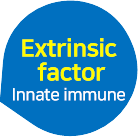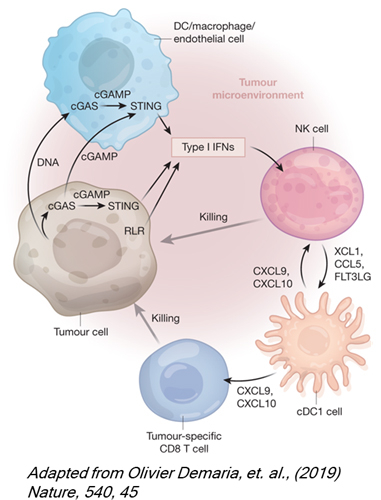HOME / SCIENCE / Innate immune
Innate immune

STING pathway of
innate immune system

There are 7 signaling pathways that involved in innate immune responses against invading pathogens. Each pathway recognizes distinct molecular pattern released by pathogens. STING is an endoplasmic reticulum-resident transmembrane protein that drives the recognition of one of the molecular patterns, intracellular DNA, to invoke innate immune response. Due to the inherent genomic instability of cancer cells and resulting cytosolic DNA within, STING pathway has been known as an essential pathway for inducing immune responses against tumor cells. Activation of STING (by natural ligand, cyclic GMP-AMP, cGAMP) triggers production of type I interferon in cancer cells, but activation outside the tumor cells (tumor-Extrinsic factor) is required to induced anti-tumor immune responses. First generation STING agonists (analogs of cGAMP) have been evaluated in clinical setting, but overall responses were disappointing, due to low ORR. There is an urgent needs to develop new way to activate the STING pathway.
At Txinno Bioscience, we are developing both ENPP1 inhibitor (best-in-class) and ‘Target Z’ inhibitor (first-in-class) as small molecule immune modulators of STING signaling pathway.
Innate immune activation by ENPP1 inhibitor
Ectonucleotide pyrophosphatase/phosphodiesterase 1 (ENPP1), is a type II transmembrane protein with nucleotide pyrophosphatase and phosphodiesterase enzymatic activities. Recently, ENPP1 has been found to play an important role in regulating STING pathway as the “innate immune checkpoint”. By hydrolyzing cGAMP (natural ligand of STING) into AMP and GMP, ENPP1 negatively regulates STING-mediated type I interferon production and subsequently prevents innate immune response against tumor. It was suggested that cancer cells acquire immune evasiveness by increasing ENPP1 expression, reflecting over-expression of ENPP1 in many different cancer types.
At Txinno Bioscience, we are developing a small molecule ENPP1 inhibitor based on following advantages; 1) in stark contrast to STING agonist, ENPP1 inhibitor would maintain endogenous cGAMP, confer physiological level of STING activation in TME and minimize immune-related side effects , and 2) orally available ENPP1 inhibitor can overcome shortcomings of intra-tumoral injection required for current STING agonists.

